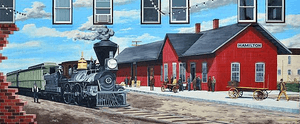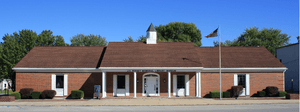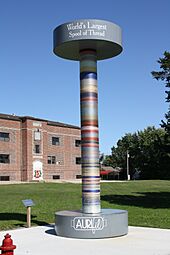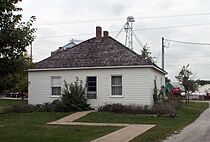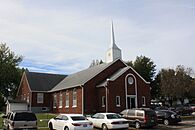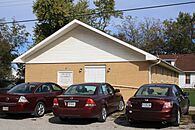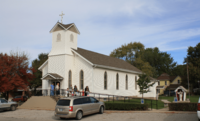Hamilton, Missouri facts for kids
Quick facts for kids
Hamilton, Missouri
|
|
|---|---|
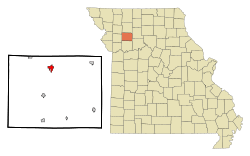
Location of Caldwell County
|
|
| Country | United States |
| State | Missouri |
| County | Caldwell |
| Area | |
| • Total | 1.48 sq mi (3.82 km2) |
| • Land | 1.47 sq mi (3.80 km2) |
| • Water | 0.01 sq mi (0.02 km2) |
| Elevation | 991 ft (302 m) |
| Population
(2020)
|
|
| • Total | 1,690 |
| • Density | 1,150.44/sq mi (444.32/km2) |
| Time zone | UTC-6 (Central (CST)) |
| • Summer (DST) | UTC-5 (CDT) |
| ZIP code |
64644
|
| Area code(s) | 816 |
| FIPS code | 29-30034 |
| GNIS feature ID | 2394277 |
Hamilton is a city in northern Caldwell County, Missouri, in the United States. In 2020, about 1,690 people lived there. Hamilton is famous for being the hometown of two important business people. One was James Cash Penney, who started the large clothing store chain, J. C. Penney. The other is Jenny Doan, who built a huge quilting business called Missouri Star Quilt Co.
Contents
Hamilton's History
Hamilton exists largely because of the Hannibal and St. Joseph Railroad. Before 1854, the area was mostly empty prairie land. When the railroad was planned, a company was formed to build a town along the tracks.
How Hamilton Got Its Name
The new town was first going to be called Prairie City. But Albert Gallatin Davis, a key person in the town company, chose the name Hamilton instead. He named it after two important early Americans. One was Alexander Hamilton, a Founding Father and the first Treasury Secretary. The other was Joseph Hamilton, a lawyer and military leader who died in the War of 1812.
Early Days of the Town
The very first house in Hamilton was built by Albert Gallatin Davis in 1855. He also opened the first business, a general store, in 1857. This store became Hamilton's first post office, and Davis was the first postmaster in 1858. The Hannibal & St. Joseph Railroad was finished on February 14, 1859. The first train arrived that same day. A train depot was built by the fall of 1859, and Davis became the first railroad agent.
Hamilton During the Civil War
When the American Civil War started, Hamilton had about 25 homes and businesses. The town was not heavily involved in the war. Most residents supported the Union side. Those who supported the Confederacy had to promise their loyalty to the Union. Because Hamilton was on the train line, it was a possible target for Confederate "bushwhackers." So, in 1861, Union soldiers arrived to help protect the town.
Growth After the War
After the Civil War ended, Hamilton grew very quickly. It officially became a city in 1868. New areas of land were added to the town, and the population grew to several hundred people. After a short slowdown in 1873, growth continued. By the mid-1880s, Hamilton had two newspapers and two banks. It also had hotels, flour mills, and other businesses. About 1,800 people lived there.
Coal Mining in Hamilton
Coal mining became important to Hamilton's economy in the early 1880s. The Hamilton Coal Company started mining in 1883, about two miles outside of town. A special train track was built to connect the coal mine to the main railroad line.
Hamilton's Geography
Hamilton is located at 39°44′38″N 93°59′56″W / 39.74389°N 93.99889°W. The city covers about 1.41 square miles (3.65 square kilometers). Most of this area is land, with a small amount of water.
Hamilton's Climate
| Climate data for Hamilton, Missouri (1991–2020 normals, extremes 1954–present) | |||||||||||||
|---|---|---|---|---|---|---|---|---|---|---|---|---|---|
| Month | Jan | Feb | Mar | Apr | May | Jun | Jul | Aug | Sep | Oct | Nov | Dec | Year |
| Record high °F (°C) | 72 (22) |
78 (26) |
86 (30) |
92 (33) |
97 (36) |
102 (39) |
109 (43) |
108 (42) |
100 (38) |
96 (36) |
82 (28) |
72 (22) |
109 (43) |
| Mean daily maximum °F (°C) | 35.2 (1.8) |
40.2 (4.6) |
52.3 (11.3) |
63.3 (17.4) |
73.1 (22.8) |
82.3 (27.9) |
86.8 (30.4) |
85.5 (29.7) |
78.0 (25.6) |
65.9 (18.8) |
51.5 (10.8) |
39.8 (4.3) |
62.8 (17.1) |
| Daily mean °F (°C) | 25.4 (−3.7) |
29.9 (−1.2) |
41.2 (5.1) |
51.7 (10.9) |
62.4 (16.9) |
72.0 (22.2) |
76.4 (24.7) |
74.6 (23.7) |
66.0 (18.9) |
53.9 (12.2) |
40.9 (4.9) |
30.0 (−1.1) |
52.0 (11.1) |
| Mean daily minimum °F (°C) | 15.6 (−9.1) |
19.6 (−6.9) |
30.0 (−1.1) |
40.2 (4.6) |
51.7 (10.9) |
61.7 (16.5) |
66.0 (18.9) |
63.7 (17.6) |
54.1 (12.3) |
41.9 (5.5) |
30.3 (−0.9) |
20.1 (−6.6) |
41.2 (5.1) |
| Record low °F (°C) | −27 (−33) |
−27 (−33) |
−17 (−27) |
7 (−14) |
25 (−4) |
34 (1) |
43 (6) |
40 (4) |
27 (−3) |
14 (−10) |
−10 (−23) |
−27 (−33) |
−27 (−33) |
| Average precipitation inches (mm) | 1.10 (28) |
1.64 (42) |
2.81 (71) |
3.99 (101) |
5.78 (147) |
4.96 (126) |
3.86 (98) |
4.27 (108) |
4.25 (108) |
3.29 (84) |
2.25 (57) |
1.72 (44) |
39.92 (1,014) |
| Average snowfall inches (cm) | 2.9 (7.4) |
1.5 (3.8) |
1.0 (2.5) |
0.1 (0.25) |
0.0 (0.0) |
0.0 (0.0) |
0.0 (0.0) |
0.0 (0.0) |
0.0 (0.0) |
0.0 (0.0) |
0.5 (1.3) |
1.6 (4.1) |
7.6 (19) |
| Average precipitation days (≥ 0.01 in) | 5.8 | 5.7 | 7.9 | 10.1 | 11.3 | 9.8 | 8.2 | 8.1 | 7.7 | 8.1 | 6.4 | 6.0 | 95.1 |
| Average snowy days (≥ 0.1 in) | 1.2 | 1.3 | 0.4 | 0.1 | 0.0 | 0.0 | 0.0 | 0.0 | 0.0 | 0.0 | 0.3 | 1.0 | 4.3 |
| Source: NOAA | |||||||||||||
Hamilton's Population
| Historical population | |||
|---|---|---|---|
| Census | Pop. | %± | |
| 1870 | 975 | — | |
| 1880 | 1,200 | 23.1% | |
| 1890 | 1,641 | 36.8% | |
| 1900 | 1,804 | 9.9% | |
| 1910 | 1,761 | −2.4% | |
| 1920 | 1,689 | −4.1% | |
| 1930 | 1,572 | −6.9% | |
| 1940 | 1,655 | 5.3% | |
| 1950 | 1,728 | 4.4% | |
| 1960 | 1,701 | −1.6% | |
| 1970 | 1,645 | −3.3% | |
| 1980 | 1,582 | −3.8% | |
| 1990 | 1,737 | 9.8% | |
| 2000 | 1,813 | 4.4% | |
| 2010 | 1,809 | −0.2% | |
| 2020 | 1,690 | −6.6% | |
| U.S. Decennial Census | |||
In 2010, Hamilton had 1,809 people living in 719 households. About 34% of households had children under 18. The average age in the city was 38.1 years old.
Education in Hamilton
Public schools in Hamilton are managed by the Hamilton R-II School District. This district has one elementary school, one middle school, and Penney High School. The city also has a public library called the Hamilton Public Library.
Community and Support
The largest church in Hamilton is the United Methodist Church. It has programs to help the community, including a big thrift store. Different churches also help people with emergency needs. The city hall helps connect people with assistance programs.
Local Businesses
Missouri Star Quilt Company was started by the Doan siblings. They wanted to support their mother, Jenny Doan, who is a talented quilter with a popular YouTube channel. This business has grown very large, earning millions of dollars each year. It owns 26 buildings in Hamilton and partly owns three restaurants. Missouri Star Quilt Company brings up to 8,000 quilters to Hamilton every month. It is now the biggest employer in Caldwell County, with 450 employees. In 2015, the Doan siblings were named the Missouri Small Business Persons of the Year. They also won the national award from the Small Business Administration.
Attractions in Hamilton
Because of the active quilt business, Hamilton built The World's Largest Spool of Thread. It is 22 feet tall and 8 feet wide. It was shown to the public in September 2019. This giant spool holds 1 million yards of thread! You can find it at 300 East Bird in Hamilton, near the Missouri Quilt Museum.
Famous People from Hamilton
- Jenny Doan: A famous quilter.
- Dorothea Daley Engel (1916-2004): A U.S. Army nurse whose experiences in the Battle of Bataan inspired a movie role for actress Claudette Colbert.
- Dandi Daley Mackall: An author who won an Edgar Awards in 2012 for her mystery fiction. One of her 500 books was made into a Hallmark Channel movie.
- James Cash Penney (1875-1971): The founder of J.C. Penney stores. His childhood farm home has been moved to town and is now a museum.
- Zack Wheat (1888-1972): A baseball player for the Brooklyn Dodgers who is in the National Baseball Hall of Fame and Museum.
Gallery
See also
 In Spanish: Hamilton (Misuri) para niños
In Spanish: Hamilton (Misuri) para niños



